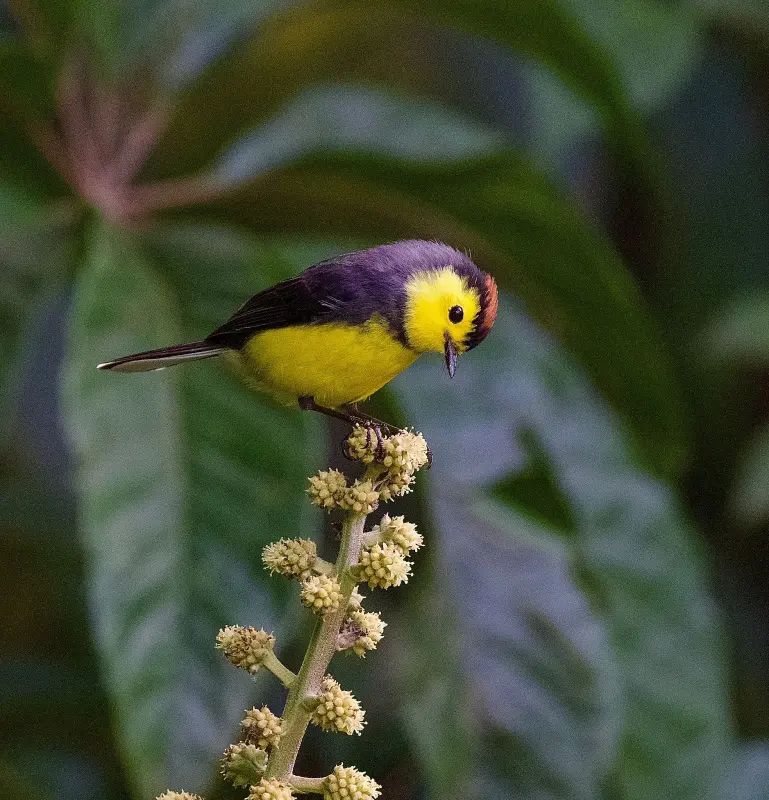Collared Whitestart, Collared Redstart

Myioborus torquatus
Scientific Name
Parulidae (New World Warblers)
Family
Passeriformes
Order
No recognized subspecies; monotypic species.
Subspecies.
Range and Habitat of Collared Whitestart, Collared Redstart
Geographic Range
Primarily found in the highlands of Central America, especially in Costa Rica and western Panama. Its range is concentrated in montane forests and cloud forests.
Migratory Patterns
Generally a resident bird, though some altitudinal movements may occur, especially between breeding and non-breeding seasons in search of food.
Preferred Habitat
Moist montane forests, cloud forests, and forest edges at elevations between 1,200 and 3,000 meters.
Altitude Range
Found predominantly in high-elevation forests from 1,200 to 3,000 meters (4,000–10,000 feet).
Costa Rica Habitat
In Costa Rica, Collared Whitestart thrives in highland regions such as the Talamanca Range, Poás Volcano National Park, and Monteverde Cloud Forest Reserve.
Conservation Status
Least Concern
Conservation Status
Population Status
The global population is stable and widespread within its range, and it is classified as Least Concern.
Habitat loss due to deforestation and climate change, particularly in the high-elevation cloud forests. However, many of its habitats in Costa Rica are protected within national parks and reserves.
Conservation efforts
Protected areas such as Monteverde Cloud Forest Reserve and Chirripó National Park play a crucial role in conserving the Collared Whitestart’s habitat. Sustainable ecotourism efforts in Costa Rica have also contributed to its conservation.
Primary Threats
Habitat loss due to deforestation and climate change, particularly in the high-elevation cloud forests. However, many of its habitats in Costa Rica are protected within national parks and reserves.
Collared Whitestart, Collared Redstart Identification
How to Identify the Species
Rarity Level:
CommonBest Viewing Times:
Early Morning (Dawn - 8 AM), Late Morning (8 AM - 11 AM)
Size
Length: 12.5 – 13.5 cm (4.9 – 5.3 in) Weight: Around 9 – 10 grams (0.32 – 0.35 oz)
Plumage
Bright yellow breast and belly with a contrasting black collar across the upper chest. The back is olive-gray, with a striking white tail and reddish crown. The wings are dark with some white spots on the tail visible during flight.
Juveniles: Duller coloration with less contrast between yellow and gray, and less pronounced collar.Distinctive Features
The bold black collar around the neck and bright yellow underparts, along with its signature tail-fanning behavior, make this bird highly distinctive.
Sexual Dimorphism
Males and females look similar, though males may exhibit slightly brighter coloration.
Diet and Feeding Behavior
Primary Diet
- Feeding primarily on small insects and spiders. Occasionally supplements its diet with small fruits.
Foraging Techniques
- Frequently fans its white tail to flush insects from foliage, making them easier to capture. Often forages in mixed-species flocks.
Feeding Times
- Active throughout the day, especially in the early morning and late afternoon.
Behavior Patterns
Collared Whitestart, Collared Redstart
Social Structure
Often found in pairs or small family groups, but also associates with mixed-species flocks.
Song and Vocalization
The Collared Whitestart produces a high-pitched, sweet trill or series of whistles, often heard during territorial displays. Its call can be a sharp “cheet” sound.
Courtship and Mating Ritual
Males perform tail-fanning displays to showcase their striking tail and collar while singing to attract mates.
Territoriality
Highly territorial, especially during the breeding season, defending both feeding and nesting areas from other birds.
Birdwatching Tips
Best Locations for Spotting Collared Whitestart, Collared Redstart
In Costa Rica, head to highland areas like Monteverde Cloud Forest Reserve, Cerro de la Muerte, and the Talamanca Mountains. Poás Volcano National Park and Tapantí National Park are also excellent locations.

Best Time of the Year
Year-round in Costa Rica, though activity may increase during the breeding season (March to July).
Common Behavior
Look for its characteristic tail-fanning behavior while foraging. It tends to be active, often found flitting through the mid-level canopy or forest edge.
Recommended Gear
Binoculars with good close-focus capability are ideal for observing its rapid movements. A lightweight camera with fast autofocus can be useful for photographing its distinctive tail fanning.
Breeding and Nesting Behavior
Breeding Season
In Costa Rica, breeding typically occurs from March to July, during the rainy season when food is plentiful.
Nesting Sites
Nests are built on the ground or low in vegetation, typically made of moss, leaves, and plant fibers. They are well-concealed in dense undergrowth.
Clutch Size
Usually 2-3 eggs per clutch.
Incubation Period
Parental Care
Both parents participate in feeding the young, which fledge after about 10-12 days.
Did You Know?
How do I identify this bird?
Look for the bright yellow underparts, distinctive black collar, and the white tail that is often fanned while foraging. Its reddish crown is also a key identifier.
Where is the best place to see it?
Highland cloud forests in Costa Rica, especially in Monteverde and the Talamanca Mountains, are prime spots for observing this species.
Is this bird endangered?
No, the Collared Whitestart is currently listed as Least Concern, though habitat protection remains crucial.
Interesting Behaviors
The Collared Whitestart’s unique tail-fanning behavior serves as both a foraging technique and a visual display during social interactions.
Cultural Significance
In Costa Rica, it is sometimes referred to as “amigo del hombre” (“friend of man”) due to its curious nature and tendency to approach human settlements in search of insects.
Interaction with people
This is a gregarious, curious bird. Instead of shying away from people, it tends to perch close by, seemingly interested in observing the observers.
Formerly called the Collared Redstart
This species was formerly called the Collared Redstart, then changed to Whitestart, but is continually referred to by both names.